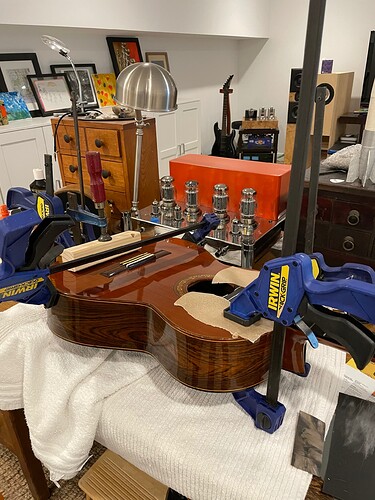@Jamolay;
Thanks - it cleaned up pretty good and now plays as it was meant to. I’ve worked mostly on electrics, but starting to play acoustic more and want to be able to care and service them properly also. I’m a rookie and don’t have a ton of tools, and much more a fearless (but cautious) tinkerer than a wood craftsman so I buy tools and learn trade tricks as needed. The Bullet was a good learning project and you are right - the bond that comes with bringing a guitar back to life is the payout. Interestingly, through these projects, I’ve come to really appreciate all guitars regardless of brand-name or perceived quality, even the likes of bottom-end Bullets. It really does ‘break my heart’ to see how some are thrashed, and I see no ‘romance’ in it at all.
This hard-to-find1967-68 hollow-body Kent (Kawai) was purchased at auction. It was part of a large collection that included drool-worthy Martin, Taylor, Alvarez, Gibson and Fender guitars as well as mandolins, banjos, violins, amps etc. It appeared to have been sitting in it’s original case, apparently untouched for maybe 20-30 years. After some necessary fret and neck work, action adjustments, a gentle cleaning and new strings, it plays like whipped cream tastes and has quickly become my ‘new favorite’. Pretty sexy, huh…?
I’ve never heard of dehydration cracks, and would like to see a pic of the ‘hack job’. I don’t know about you, but for better or worse, my mistakes are the first thing I see in a finished project. Sigh…
As for truss rods, I’m to understand that the same adjustment principles and processes apply irregardless of electric/acoustic, providing there is one to begin with.
@Malz;
Thanks for the tip - I have used Stew-Mac quite a lot - that old guy is like everybody’s favorite grandfather! I’ve gotten some good leads to resources from other responders and always looking to expand my knowledge resource library,
@TheCluelessLuthier
I was to understand that it was the sound board had caved on Robert’s Dorado - perhaps I misunderstood. An over-relieved neck can be corrected. Some require a more intense approach than than others, depending. But
if it’ is the soundboard and
if it’s because of exposure to low humidity, I’d try introducing moisture first because it’s relatively non-invasive, effective and low cost.
On a separate note, I applaud you for your new direction. (“When passion meets ability, expect a masterpiece” - John Ruskin). The design possibilities are endless. I bought a Stew-Mac Strat once and wanted to carve a design into the body, but had too much going on and never got around to it. Maybe someday…Think about sharing some pics of your projects at various stages of completion. And finally, thanks for the site suggestions - you can never have too many!
![]() )
)





